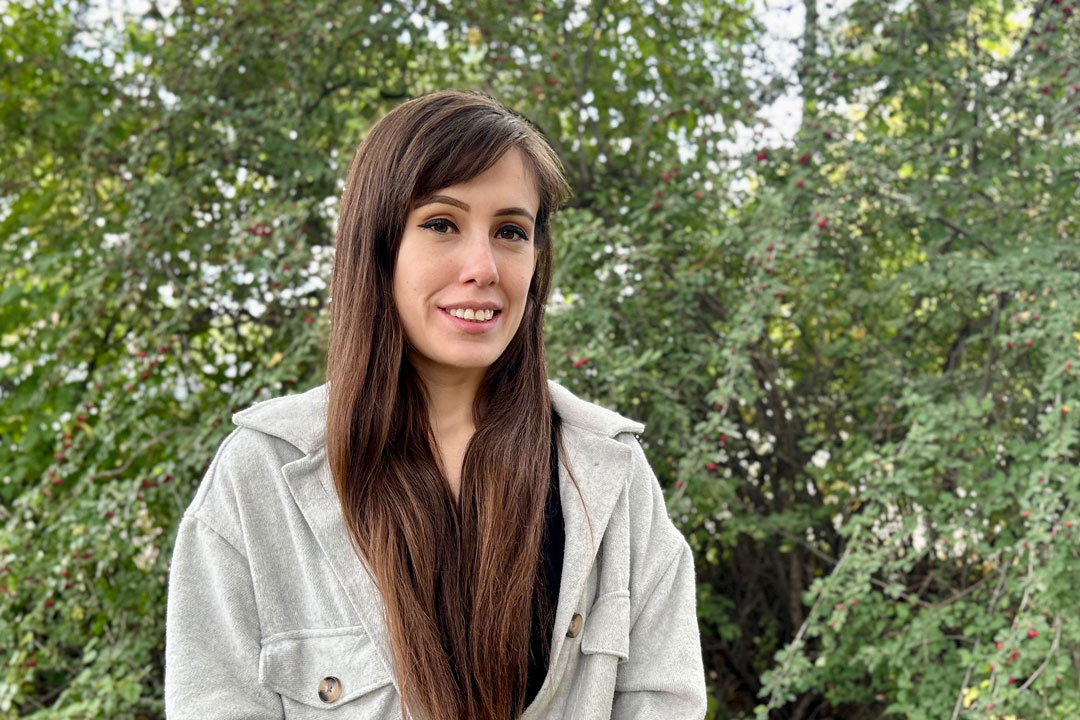
Giving care to Saskatchewan’s most ancient landscapes
For alumna Hillary Kyplain (BScRRM‘22), a conservation co-ordinator for Métis Nation-Saskatchewan, protecting the Muskeg is more than just a job.
By Jane CaulfieldNorthern Saskatchewan is blanketed with Muskeg, the name Indigenous people give to what is also known as peatland or wetland. They are vital ecosystems, providing food and sustenance to animals and traditional medicines to Indigenous communities. They also have an important role in mitigating the effects of climate change – they absorb run-off, filter water, and are where the Woodland Caribou goes during calving season.
“They are an important carbon sink and not a lot of people know about that,” said Kyplain, who works as part of the Métis Nation–Saskatchewan Ministry of Lands and Environment on the Li Muskeg Ni Pishkaapahtaynaan (Protect Our Muskegs) project. “It’s really important to take care of them.”
A carbon sink is the name scientists give to the natural process where more carbon dioxide is absorbed from the atmosphere than it releases. When plants, trees, and animals decompose in the Muskeg, they break down in a thick layer of mud. The mud – the peat – holds on to the carbon from the decomposed materials, conserving it in the ground.
Part of the work Kyplain does is working with local communities and organizations to help ensure the Muskeg is protected so that it can continue to provide sustenance for future generations.
“We are the only province that doesn’t have any policy to support and protect peatlands,” she said. “We have partnered with a group called For Peat’s Sake, who originally formed in response to a peat mining proposal in 2018 to help advocate for the continued protection of the peatlands.”
Kyplain also works to improve education about the benefits and importance of peatlands with school divisions and organizations across the province.
“Not a lot of people know about peatlands and why they are important. Lots of people think it’s just viable land for development,” she said. “We’ve worked with the school divisions to develop a middle school unit on the benefits of peatlands.”
Some of her educational work includes Muskeg Conservation Workshops, which focus on educating participants about the importance of conserving Muskegs and about the lack of protection policies in place. Most recently, she held one in August during the Métis Nation-Saskatchewan-sponsored Women’s Protecting the Land Camp in La Ronge at the Lac La Ronge Indian Band Youth Haven-Little Hills. The three-day camp aimed to reconnect women and children with nature and engage in land-based activities, including medicine gathering in the nearby Muskegs.
“It’s a great way to highlight how vital peatlands are to the ecosystem and to Indigenous people,” she said.
Finding a career path that makes sense at USask
When Kyplain first started her educational journey, she thought she was going in a particular direction.
“I was always interested in learning biology and environmental sciences. I was obsessed with animals,” she said. “So, when I started at USask, that’s what I took.”
But after realizing that she wasn’t a fan of some aspects of the course load, she started looking at what else the university had to offer. That’s when she discovered the Renewable Resources Management Program in the College of Agriculture and Bioresources.
“It was the program you take when you’re interested in becoming a conservation officer, which is what I thought I wanted to do,” she said. “But once I was in there, I realized that I could do a lot of things with this kind of degree.”
After switching programs, Kyplain said that a whole new world of opportunities presented themselves – many of which she tried. When she was still a student, she spent her summers working as an environmental technician at companies such as Cameco. After graduation, she landed a job working for the Lac La Ronge Indian Band as a community energy co-ordinator, helping the band adopt more renewable energy solutions and identify ways to conserve energy throughout the community.
Kyplain credits her ability to move into different roles with ease to the diversity of courses taken during her time at USask. Even when they are roles she didn’t think she wanted.
“I can adapt to the different roles I get put into,” she said. “I didn’t necessarily want a career where I would have to deal with the public, but that’s what I am doing a lot of now and it’s not so bad. Having several different kinds of classes across different areas really helped me learn how to adapt to new situations.”
“During my time at USask, I did a lot of science and a lot of economics,” she said. “I learned a lot about many things,” she said. “I got to try out a lot of different kinds of career opportunities until I found one that fit.”
Together we will support and inspire students to succeed. We invite you to join by supporting current and future students' needs at USask.

